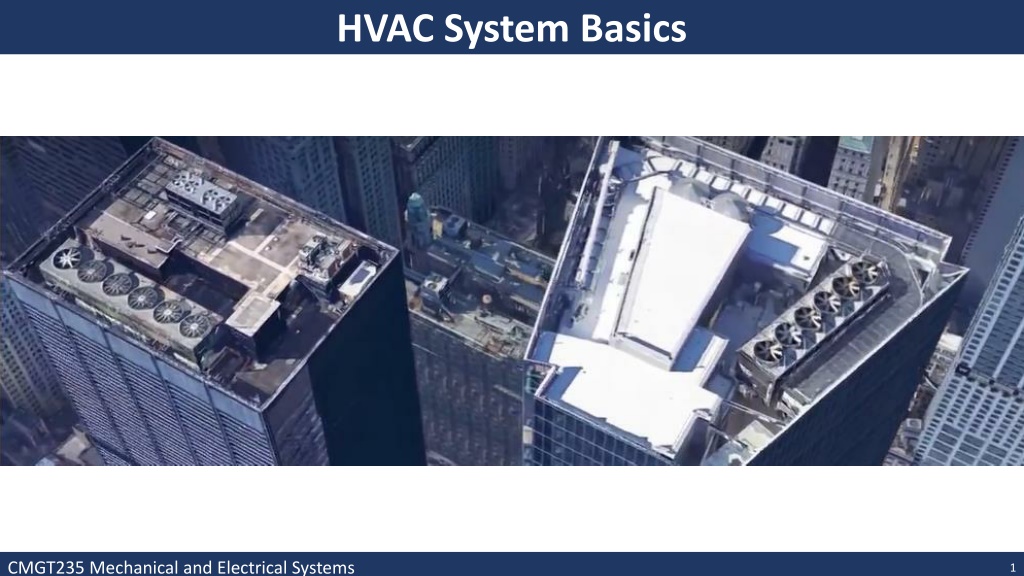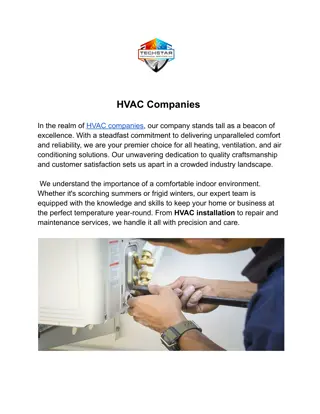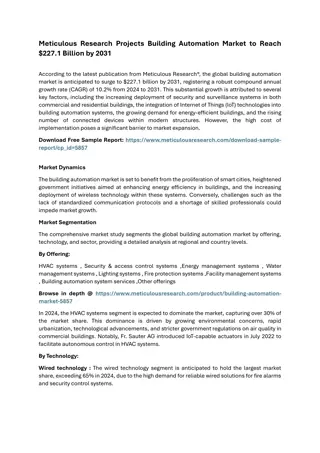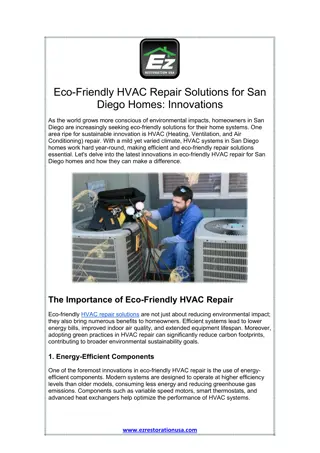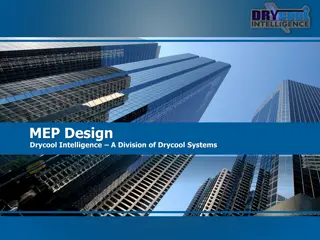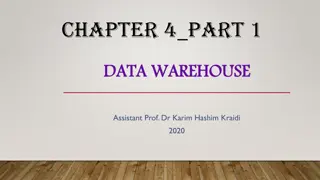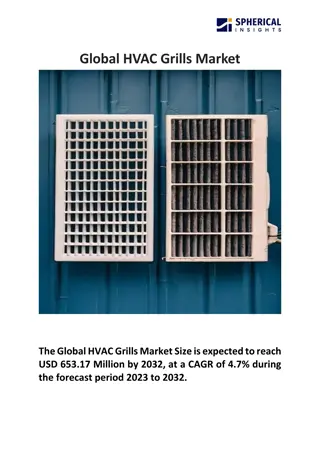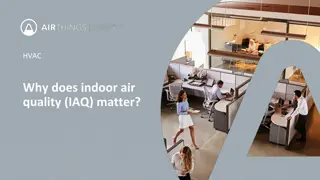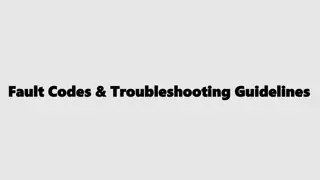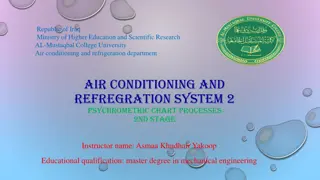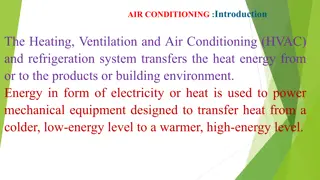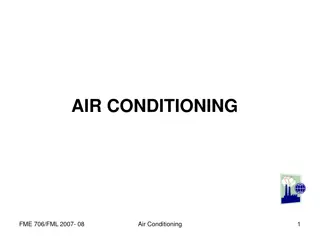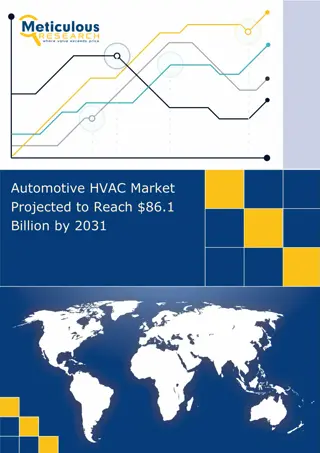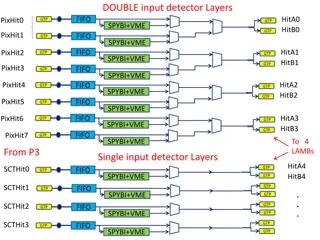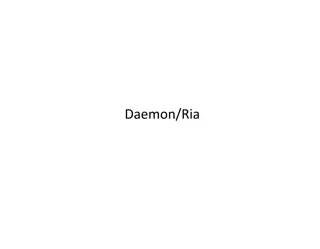Understanding HVAC Systems: Basics, Purpose, and Functionality
Explore the foundational concepts of HVAC systems, including their basic purpose in providing thermal comfort, humidity control, ventilation, air filtration, and space pressurization. Learn about heat gain versus heat loss considerations and the two general types of air conditioning methods. Gain insights into the mechanical and electrical aspects of HVAC systems through comprehensive visual aids and descriptions.
Download Presentation

Please find below an Image/Link to download the presentation.
The content on the website is provided AS IS for your information and personal use only. It may not be sold, licensed, or shared on other websites without obtaining consent from the author. Download presentation by click this link. If you encounter any issues during the download, it is possible that the publisher has removed the file from their server.
E N D
Presentation Transcript
HVAC System Basics CMGT235 Mechanical and Electrical Systems 1
Basic Purpose of HVAC Air-Conditioning for thermal and humidity comfort CMGT235 Mechanical and Electrical Systems 2
Basic Purpose of HVAC Ventilation Introduction of required outside air CMGT235 Mechanical and Electrical Systems 3
Basic Purpose of HVAC Ventilation Filtration ASHRAE 52.2 CMGT235 Mechanical and Electrical Systems 4
Basic Purpose of HVAC Ventilation Exhaust of undesirable air (toilet, kitchen, lab exhaust) CMGT235 Mechanical and Electrical Systems 5
Basic Purpose of HVAC Ventilation Air movement in space CMGT235 Mechanical and Electrical Systems 6
Basic Purpose of HVAC Space pressurization Control infiltration Makeup of exhausted air CMGT235 Mechanical and Electrical Systems 7
Heat Gain vs Heat Loss Heat Gains Solar thru windows / walls Summer transfer / infiltration Internal Electric use, Lighting & Equipment Body Heat Heat Loss Air Leaks (infiltration) Transfer Walls Roofs Floor Windows CMGT235 Mechanical and Electrical Systems 8
Heat Gain vs Heat Loss CMGT235 Mechanical and Electrical Systems 9
Air Conditioning Two general types of air conditioning (cooling) Refrigeration-based: refrigerant cycle moves heat from space (indoors) to another (outdoors) Refrigerant has a low boiling point, making it ideal for HVAC systems Like a car AC Non-refrigerant: evaporative cooling CMGT235 Mechanical and Electrical Systems 10
Air Conditioning Simple vs. Complex CMGT235 Mechanical and Electrical Systems 11
System Capacity Sizing Verify that cooling and heating capacity sizing (load calculations) have been completed (C403.2.1) CMGT235 Mechanical and Electrical Systems 12
System Capacity Sizing Verify that equipment is not unreasonable over-sized (C403.2.2) Why? CMGT235 Mechanical and Electrical Systems 13
Ventilation Two types Mechanical ventilation (Active) CMGT235 Mechanical and Electrical Systems 14
Ventilation Two types Natural ventilation (Passive) CMGT235 Mechanical and Electrical Systems 15
Simple HVAC Systems Package Units Thru-wall air conditioner Package Terminal Air Conditioner (PTAC) Package Terminal Heat Pump (PTHP) Unitary Air conditioner Furnace Heat Pumps Packaged, split, mini-split Variable refrigerant Flow (VRF) CMGT235 Mechanical and Electrical Systems 16
Packaged Rooftop Cooling Unit (RTU) CMGT235 Mechanical and Electrical Systems 17
Refrigeration Cycle CMGT235 Mechanical and Electrical Systems 18
Variable Refrigerant Flow (VRF) CMGT235 Mechanical and Electrical Systems 19
Energy Code CMGT235 Mechanical and Electrical Systems 20
Top of the Charts Most Impactful Basic HVAC Control Measures Snow and ice melt heater control Temperature setback scheduling Full 5-degree thermostat deadband Economizer controls Limits on simultaneous heating and cooling (VAV reheat) VAV ventilation optimization Supply air temperature & fan static reset controls Exterior ductwork insulation (C403.2.9) Fan power limits Proper equipment sizing Commissioning CMGT235 Mechanical and Electrical Systems 21
Snow and Ice Melt Heater Control Snow and ice melt heaters will use a large amount of energy if not properly and automatically controlled CMGT235 Mechanical and Electrical Systems 22
Temperature Setback Scheduling Simple control systems Programmable thermostats Seven different daily schedules/week Manual override Occupant sensor is an alternative DDC (Direct Digital Control) systems Central scheduling of all units Optimum start activated CMGT235 Mechanical and Electrical Systems 23
Full 5-degree Thermostat Deadband Economizer Controls A most significant control feature is temperature deadband If heating is set at 70 F, then cooling should be 75 F Should be the found condition during an inspection Why? Simple systems can fight each other in open office areas VAV systems have excessive reheat if settings are too tight Energy Star recommended factory default setpoints of: Heating 70 F Cooling 78 F CMGT235 Mechanical and Electrical Systems 24
HVAC Economizers Free Cooling Quantity of Outside Air (OA): Meet Minimum Ventilation Requirement Economizer Function: Flush out building heat with cool outside air CMGT235 Mechanical and Electrical Systems 25
Packaged Rooftop Cooling Unit CMGT235 Mechanical and Electrical Systems 26
Basic OA Economizer Idea CMGT235 Mechanical and Electrical Systems 27
Top of the Charts Most Impactful Basic HVAC Control Measures Snow and ice melt heater control Temperature setback scheduling Full 5-degree thermostat deadband Economizer controls Limits on simultaneous heating and cooling (VAV reheat) VAV ventilation optimization Supply air temperature & fan static reset controls Exterior ductwork insulation (C403.2.9) Fan power limits Proper equipment sizing Commissioning CMGT235 Mechanical and Electrical Systems 28
Ductwork in Attics or Outside the Building CMGT235 Mechanical and Electrical Systems 29
Overall Fan System Efficiency CMGT235 Mechanical and Electrical Systems 30
Complex Building Energy Use - HVAC CMGT235 Mechanical and Electrical Systems 31
Heating and Cooling CMGT235 Mechanical and Electrical Systems 32
Central Plant: Boilers CMGT235 Mechanical and Electrical Systems 33
Central Plant: Chillers CMGT235 Mechanical and Electrical Systems 34
Central Plant: Cooling Tower CMGT235 Mechanical and Electrical Systems 35
Energy Code Checks CMGT235 Mechanical and Electrical Systems 36
Complex Secondary HVAC Systems CMGT235 Mechanical and Electrical Systems 37
Secondary HVAC System Air Handlers CMGT235 Mechanical and Electrical Systems 38
Distribution: Heating Coils, Radiant Heaters CMGT235 Mechanical and Electrical Systems 39
VAV Multiple Zone System Concept CMGT235 Mechanical and Electrical Systems 40
Multiple Zone System Example: VAV Terminal Unit (VAV Box) CMGT235 Mechanical and Electrical Systems 41
